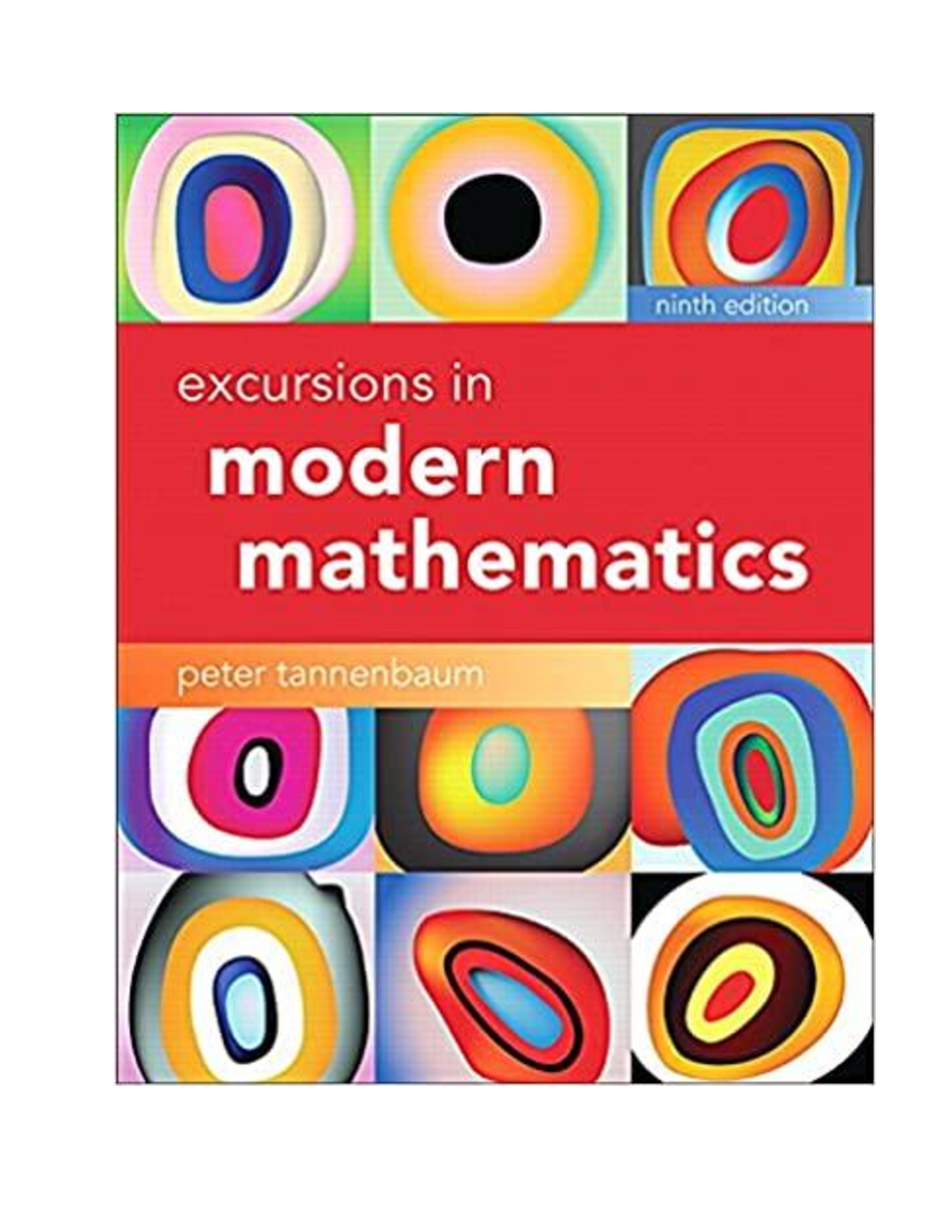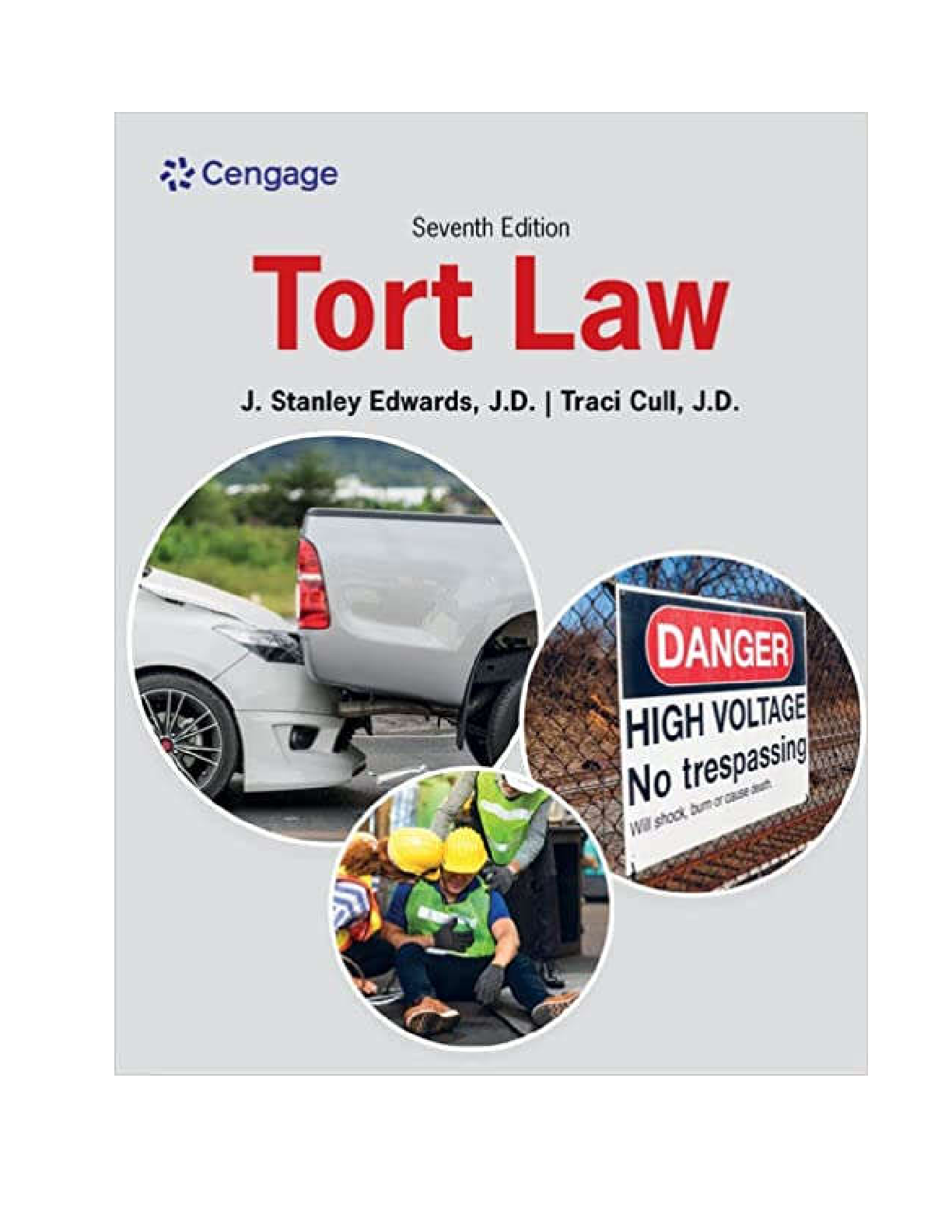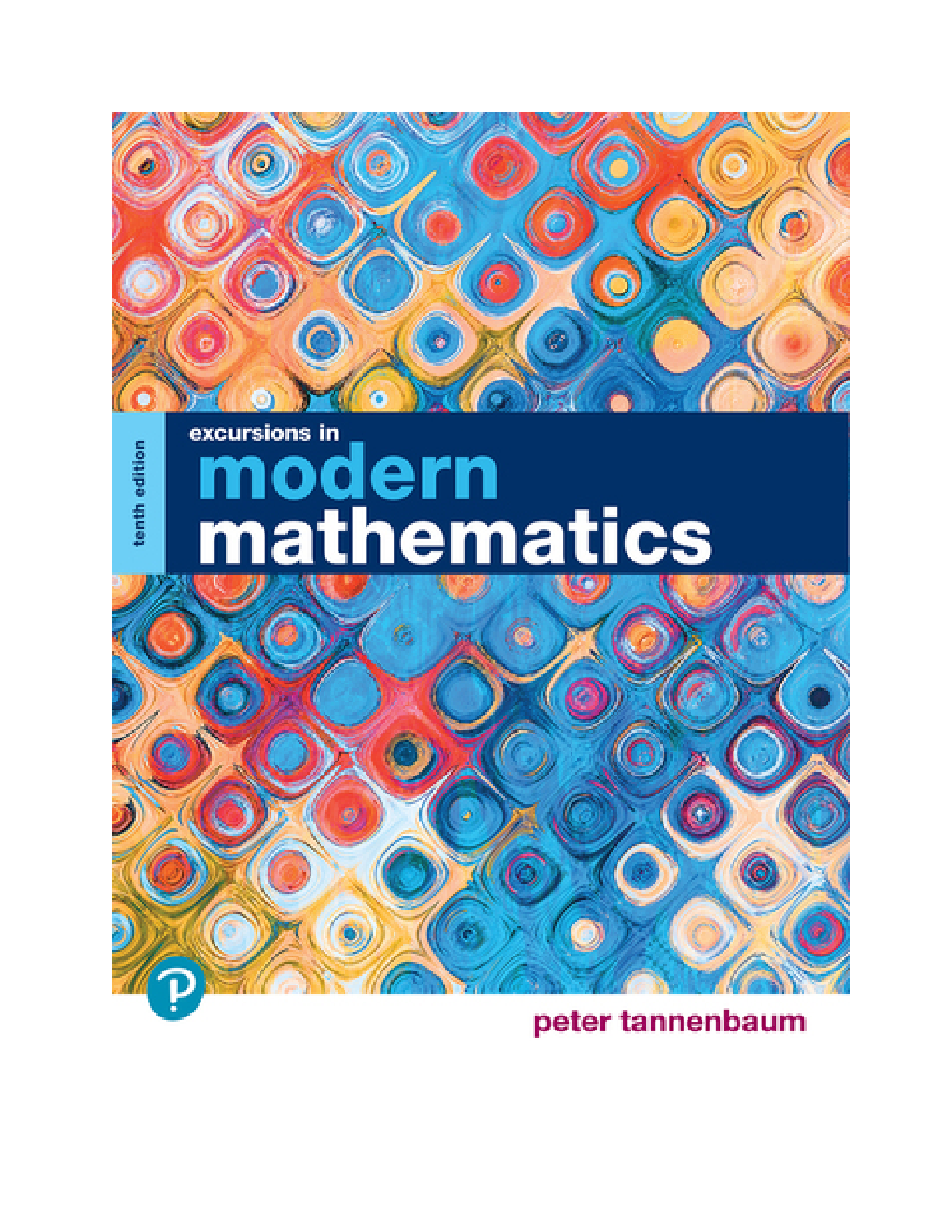Mathematics > eBook-PDF > [eBook] [PDF] Excursions in Modern Mathematics, 9th Edition By Peter Tannenbaum (All)
[eBook] [PDF] Excursions in Modern Mathematics, 9th Edition By Peter Tannenbaum
Document Content and Description Below
Excursions in Modern Mathematics Excursions in Modern Mathematics Contents Preface From the Author Outline A Final Word to the Reader New in This Edition Resources for Success MyMathLab® Onli... ne Course for Excursions in Modern Mathematics, 9th Edition by Peter Tannenbaum (access code required) Resources for Success Instructor Resources Student Resources Part 1 Social Choice 1 The Mathematics of Elections The Paradoxes of Democracy 1.1 The Basic Elements of an Election Preference Ballots and Preference Schedules Ties 1.2 The Plurality Method 1.3 The Borda Count Method 1.4 The Plurality-with-Elimination Method 1.5 The Method of Pairwise Comparisons 1.6 Fairness Criteria and Arrow's Impossibility Theorem Conclusion Key Concepts 1.1 The Basic Elements of an Election 1.2 The Plurality Method 1.3 The Borda Count Method 1.4 The Plurality-with-Elimination Method 1.5 The Method of Pairwise Comparisons 1.6 Fairness Criteria and Arrow's Impossibility Theorem Exercises Walking 1.1 Ballots and Preference Schedules 1.2 Plurality Method 1.3 Borda Count 1.4 Plurality-with-Elimination 1.5 Pairwise Comparisons 1.6 Fairness Criteria Jogging Running Applet Bytes 2 The Mathematics of Power Weighted Voting 2.1 An Introduction to Weighted Voting Notation and Examples 2.2 Banzhaf Power Shortcuts for Computing Banzhaf Power Distributions 2.3 Shapley-Shubik Power 2.4 Subsets and Permutations Subsets and Coalitions Permutations and Sequential Coalitions Conclusion Key Concepts 2.1 An Introduction to Weighted Voting 2.2 Banzhaf Power 2.3 Shapley-Shubik Power 2.4 Subsets and Permutations Exercises Walking 2.1 Weighted Voting 2.2 Banzhaf Power 2.3 Shapley-Shubik Power 2.4 Subsets and Permutations Jogging Running Applet Bytes 3 The Mathematics of Sharing Fair-Division Games 3.1 Fair-Division Games Basic Elements of a Fair-Division Game Fair Shares and Fair Divisions Fair-Division Methods 3.2 The Divider-Chooser Method 3.3 The Lone-Divider Method The Lone-Divider Method for Three Players The Lone-Divider Method for More Than Three Players 3.4 The Lone-Chooser Method The Lone-Chooser Method for Three Players The Lone-Chooser Method for N Players 3.5 The Method of Sealed Bids Auctions, Reverse Auctions, and Negative Bidding Fine-Grained, Discrete Fair Division 3.6 The Method of Markers Conclusion Key Concepts 3.1 Fair-Division Games 3.2 The Divider-Chooser Method 3.3 The Lone-Divider Method 3.4 The Lone-Chooser Method 3.5 The Method of Sealed Bids 3.6 The Method of Markers Exercises Walking 3.1 Fair-Division Games 3.2 The Divider-Chooser Method 3.3 The Lone-Divider Method 3.4 The Lone-Chooser Method 3.5 The Method of Sealed Bids 3.6 The Method of Markers Jogging Running 4 The Mathematics of Apportionment Making the Rounds 4.1 Apportionment Problems and Apportionment Methods Apportionment: Basic Concepts and Terminology 4.2 Hamilton's Method 4.3 Jefferson's Method 4.4 Adams's and Webster's Methods Adams's Method Webster's Method 4.5 The Huntington-Hill Method The Geometric Mean and The Huntington-Hill Rounding Rule The Huntington-Hill Method 4.6 The Quota Rule and Apportionment Paradoxes Apportionment Paradoxes Conclusion A Brief History of Apportionment in the United States Key Concepts 4.1 Apportionment Problems and Apportionment Methods 4.2 Hamilton's Method 4.3 Jefferson's Method 4.4 Adams's and Webster's Methods 4.5 The Huntington-Hill Method 4.6 The Quota Rule and Apportionment Paradoxes Exercises Walking 4.1 Apportionment Problems and Apportionment Methods 4.2 Hamilton's Method 4.3 Jefferson's Method 4.4 Adams's and Webster's Methods 4.5 The Huntington-Hill Method 4.6 The Quota Rule and Apportionment Paradoxes Jogging Running Applet Bytes Part 2 Management Science 5 The Mathematics of Getting Around Euler Paths and Circuits 5.1 Street-Routing Problems 5.2 An Introduction to Graphs Graphs as Models 5.3 Euler's Theorems and Fleury's Algorithm Fleury's Algorithm 5.4 Eulerizing and Semi-Eulerizing Graphs Eulerizations Semi-Eulerizations Conclusion Key Concepts 5.1 Street-Routing Problems 5.2 An Introduction to Graphs 5.3 Euler's Theorems and Fleury's Algorithm 5.4 Eulerizing and Semi-Eulerizing Graphs Exercises Walking 5.1 Street-Routing Problems 5.2 An Introduction to Graphs 5.3 Euler's Theorems and Fleury's Algorithm 5.4 Eulerizing and Semi-Eulerizating Graphs Jogging Running Applet Bytes 6 The Mathematics of Touring Traveling Salesman Problems 6.1 What Is a Traveling Salesman Problem? 6.2 Hamilton Paths and Circuits Complete Graphs 6.3 The Brute-Force Algorithm 6.4 The Nearest-Neighbor and Repetitive Nearest-Neighbor Algorithms The Repetitive Nearest-Neighbor Algorithm 6.5 The Cheapest-Link Algorithm Conclusion Key Concepts 6.1 What Is a Traveling Salesman Problem? 6.2 Hamilton Paths and Circuits 6.3 The Brute-Force Algorithm 6.4 The Nearest-Neighbor and Repetitive Nearest-Neighbor Algorithms 6.5 The Cheapest-Link Algorithm Exercises Walking 6.1 What Is a Traveling Salesman Problem? 6.2 Hamilton Paths and Circuits 6.3 The Brute-Force Algorithm 6.4 The Nearest-Neighbor and Repetitive Nearest-Neighbor Algorithms 6.5 Cheapest-Link Algorithm Jogging Running Applet Bytes 7 The Mathematics of Networks The Cost of Being Connected 7.1 Networks and Trees Networks Trees 7.2 Spanning Trees, MSTs, and MaxSTs Spanning Trees 7.3 Kruskal's Algorithm Conclusion Key Concepts 7.1 Networks and Trees 7.2 Spanning Trees, MSTs, and MaxSTs 7.3 Kruskal's Algorithm Exercises Walking 7.1 Networks and Trees 7.2 Spanning Trees, MSTs, and MaxSTs 7.3 Kruskal's Algorithm Jogging Running Applet Bytes 8 The Mathematics of Scheduling Chasing the Critical Path 8.1 An Introduction to Scheduling 8.2 Directed Graphs 8.3 Priority-List Scheduling The Priority-List Model 8.4 The Decreasing-Time Algorithm 8.5 Critical Paths and the Critical-Path Algorithm The Critical-Path Algorithm Conclusion Key Concepts 8.1 An Introduction to Scheduling 8.2 Directed Graphs 8.3 Priority-List Scheduling 8.4 The Decreasing-Time Algorithm 8.5 Critical Paths and the Critical-Path Algorithm Exercises Walking 8.1 An Introduction to Scheduling 8.2 Directed Graphs 8.3 Priority-List Scheduling 8.4 The Decreasing-Time Algorithm 8.5 Critical Paths and the Critical-Path Algorithm Jogging Running Applet Bytes Part 3 Growth 9 Population Growth Models There is Strength in Numbers 9.1 Sequences and Population Sequences Sequences Population Sequences 9.2 The Linear Growth Model Arithmetic Sums and the Arithmetic Sum Formula 9.3 The Exponential Growth Model The Geometric Sum Formula 9.4 The Logistic Growth Model Conclusion Key Concepts 9.1 Sequences and Population Sequences 9.2 The Linear Growth Model 9.3 The Exponential Growth Model 9.4 The Logistic Growth Model Exercises Walking 9.1 Sequences and Population Sequences 9.2 The Linear Growth Model 9.3 The Exponential Growth Model 9.4 The Logistic Growth Model Jogging Running Solution to the “Mystery” Sequence in Example 9.1: 10 Financial Mathematics Money Matters 10.1 Percentages Percentage Traps 10.2 Simple Interest Interest The Simple Interest Formula Bonds Payday Loans 10.3 Compound Interest Annual Compounding Certificates of Deposit General Compounding Continuous Compounding Savings Accounts Annual Percentage Yield 10.4 Retirement Savings 10.5 Consumer Debt Credit Card Debt Installment Loans Conclusion Key Concepts 10.1 Percentages 10.2 Simple Interest 10.3 Compound Interest 10.4 Retirement Savings 10.5 Consumer Debt Exercises Walking 10.1 Percentages 10.2 Simple Interest 10.3 Compound Interest 10.4 Retirement Savings 10.5 Consumer Debt Jogging Part 4 Shape and Form 11 The Mathematics of Symmetry Beyond Reflection 11.1 Rigid Motions Rigid Motions 11.2 Reflections 11.3 Rotations 11.4 Translations 11.5 Glide Reflections 11.6 Symmetries and Symmetry Types 11.7 Patterns Border Patterns Wallpaper Patterns Conclusion Key Concepts 11.1 Rigid Motions 11.2 Reflections 11.3 Rotations 11.4 Translations 11.5 Glide Reflections 11.6 Symmetries and Symmetry Types 11.7 Patterns Exercises Walking 11.1 Rigid Motions 11.2 Reflections 11.3 Rotations 11.4 Translations 11.5 Glide Reflections 11.6 Symmetries and Symmetry Types 11.7 Patterns Jogging Running 12 Fractal Geometry The Kinky Nature of Nature 12.1 The Koch Snowflake and Self-Similarity Self-Similarity 12.2 The Sierpinski Gasket and the Chaos Game The Chaos Game 12.3 The Twisted Sierpinski Gasket 12.4 The Mandelbrot Set Complex Numbers and Mandelbrot Sequences The Mandelbrot Set Conclusion Key Concepts 12.1 The Koch Snowflake and Self-Similarity 12.2 The Sierpinski Gasket and the Chaos Game 12.3 The Twisted Sierpinski Gasket 12.4 The Mandelbrot Set Exercises Walking 12.1 The Koch Snowflake and Self-Similarity 12.2 The Sierpinski Gasket and the Chaos Game 12.3 The Twisted Sierpinski Gasket 12.4 The Mandelbrot Set Jogging Running APPLET BYTES 13 Fibonacci Numbers and the Golden Ratio Tales of Rabbits and Gnomons 13.1 Fibonacci Numbers Fibonacci Numbers in Nature 13.2 The Golden Ratio Fibonacci Numbers and the Golden Ratio 13.3 Gnomons Similarity Gnomons Golden and Fibonacci Rectangles 13.4 Spiral Growth in Nature Gnomonic Growth Conclusion Key Concepts 13.1 Fibonacci Numbers 13.2 The Golden Ratio 13.3 Gnomons 13.4 Spiral Growth in Nature Exercises Walking 13.1 Fibonacci Numbers 13.2 The Golden Ratio 13.3 Gnomons 13.4 Spiral Growth in Nature Jogging Running Part 5 Statistics 14 Censuses, Surveys, Polls, and Studies The Joys of Collecting Data 14.1 Enumeration Censuses for Enumeration Surveys for Enumeration 14.2 Measurement Sampling Selection Bias Convenience Sampling Quota Sampling Random Sampling 14.3 Cause and Effect Clinical Studies Conclusion Key Concepts 14.1 Enumeration 14.2 Measurement 14.3 Cause and Effect Exercises Walking 14.1 Enumeration 14.2 Measurement 14.3 Cause and Effect Jogging Running 15 Graphs, Charts, and Numbers The Data Show and Tell 15.1 Graphs and Charts Bar Graphs, Pictograms, and Line Graphs Categorical Variables and Pie Charts Continuous Variables and Histograms 15.2 Means, Medians, and Percentiles The Average Percentiles The Median and the Quartiles A note of warning: The Five-Number Summary Box Plots 15.3 Ranges and Standard Deviations The Standard Deviation Conclusion Key Concepts 15.1 Graphs and Charts 15.2 Means, Medians, and Percentiles 15.3 Ranges and Standard Deviations Exercises Walking 15.1 Graphs and Charts 15.2 Means, Medians, and Percentiles 15.3 Ranges and Standard Deviations Jogging Running 16 Probabilities, Odds, and Expectations Measuring Uncertainty and Risk 16.1 Sample Spaces and Events Events 16.2 The Multiplication Rule, Permutations, and Combinations Permutations and Combinations 16.3 Probabilities and Odds Probability Assignments Equiprobable Spaces Odds 16.4 Expectations Weighted Averages 16.5 Measuring Risk Conclusion Key Concepts 16.1 Sample Spaces and Events 16.2 The Multiplication Rule, Permutations, and Combinations 16.3 Probabilities and Odds 16.4 Expectations 16.5 Measuring Risk Exercises Walking 16.1 Sample Spaces and Events 16.2 The Multiplication Rule, Permutations, and Combinations 16.3 Probabilities and Odds 16.4 Expectations 16.5 Measuring Risk Jogging 17 The Mathematics of Normality The Call of the Bell 17.1 Approximately Normal Data Sets 17.2 Normal Curves and Normal Distributions Standardizing Normal Data 17.3 Modeling Approximately Normal Distributions 17.4 Normality in Random Events Conclusion Key Concepts 17.1 Approximately Normal Data Sets 17.2 Normal Curves and Normal Distributions 17.3 Modeling Approximately Normal Distributions 17.4 Normality in Random Events Exercises Walking 17.1 Approximately Normal Data Sets 17.2 Normal Curves and Normal Distributions 17.3 Modeling Approximately Normal Distributions 17.4 Normality in Random Events Jogging Running Answers to Selected Exercises Chapter 1 The Mathematics of Elections Walking 1.1 Ballots and Preference Schedules 1.2 Plurality Method 1.3 Borda Count 1.4 Plurality with Elimination 1.5 Pairwise Comparisons 1.6 Fairness Criteria Jogging Chapter 2 The Mathematics of Power Walking 2.1 Weighted Voting 2.2 Banzhaf Power 2.3 Shapley-Shubik Power 2.4 Subsets and Permutations Jogging Chapter 3 The Mathematics of Sharing Walking 3.1 Fair-Division Games 3.2 The Divider-Chooser Method 3.3 The Lone-Divider Method 3.4 The Lone-Chooser Method 3.5 The Method of Sealed Bids 3.6 The Method of Markers Jogging Chapter 4 The Mathematics of Apportionment Walking 4.1 Apportionment Problems and Apportionment Methods 4.2 Hamilton's Method 4.3 Jefferson's Method 4.4 Adams's and Webster's Methods 4.5 The Huntington-Hill Method 4.6 The Quota Rule and Apportionment Paradoxes Jogging Chapter 5 The Mathematics of Getting Around Walking 5.2 An Introduction to Graphs 5.3 Euler's Theorems and Fleury's Algorithm 5.4 Eulerizing and Semi-Eulerizing Graphs Jogging Chapter 6 The Mathematics of Touring Walking 6.2 Hamilton Paths and Circuits 6.3 The Brute-Force Algorithm 6.4 The Nearest-Neighbor and Repetitive Nearest-Neighbor Algorithms 6.5 The Cheapest-Link Algorithm Jogging Chapter 7 The Mathematics of Networks Walking 7.1 Networks and Trees 7.2 Spanning Trees, MSTs, and MaxSTs 7.3 Kruskal's Algorithm Jogging Chapter 8 The Mathematics of Scheduling Walking 8.2 Directed Graphs 8.3 Priority-List Scheduling 8.4 The Decreasing-Time Algorithm 8.5 Critical Paths and the Critical-Path Algorithm Jogging Chapter 9 Population Growth Models Walking 9.1 Sequences and Population Sequences 9.2 The Linear Growth Model 9.3 The Exponential Growth Model 9.4 The Logistic Growth Model Jogging Chapter 10 Financial Mathematics Walking 10.1 Percentages 10.2 Simple Interest 10.3 Compound Interest 10.4 Retirement Savings 10.5 Consumer Debt Jogging Chapter 11 The Mathematics of Symmetry Walking 11.2 Reflections 11.3 Rotations 11.4 Translations 11.5 Glide Reflections 11.6 Symmetries and Symmetry Types 11.7 Patterns Jogging Chapter 12 Fractal Geometry Walking 12.1 The Koch Snowflake and Self-Similarity 12.2 The Sierpinski Gasket and the Chaos Game 12.4 The Mandelbrot Set Jogging Chapter 13 Fibonacci Numbers and the Golden Ratio Walking 13.1 Fibonacci Numbers 13.2 The Golden Ratio 13.3 Gnomons Jogging Chapter 14 Censuses, Surveys, Polls, and Studies Walking 14.1 Enumeration 14.2 Measurement 14.3 Cause and Effect Jogging Chapter 15 Graphs, Charts, and Numbers Walking 15.1 Graphs and Charts 15.2 Means, Medians, and Percentiles 15.3 Ranges and Standard Deviations Jogging Chapter 16 Probabilities, Odds, and Expectations Walking 16.1 Sample Spaces and Events 16.2 The Multiplication Rule, Permutations, and Combinations 16.3 Probabilities and Odds 16.4 Expectations 16.5 Measuring Risk Jogging Chapter 17 The Mathematics of Normality Walking 17.2 Normal Curves and Normal Distribution 17.3 Modeling Approximately Normal Distributions 17.4 Normality in Random Events Jogging Index [Show More]
Last updated: 1 year ago
Preview 1 out of 550 pages
Instant download

Buy this document to get the full access instantly
Instant Download Access after purchase
Add to cartInstant download
Reviews( 0 )
Document information
Connected school, study & course
About the document
Uploaded On
Mar 08, 2022
Number of pages
550
Written in
Additional information
This document has been written for:
Uploaded
Mar 08, 2022
Downloads
0
Views
16



 Strategic Management Creating Competitive Advantages, 10e Gregory Dess, Gerry McNamara, Alan Eisner, Seung-Hyun Lee.png)



 Gary Donell, Clarence Byrd, Ida Chen.png)







